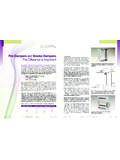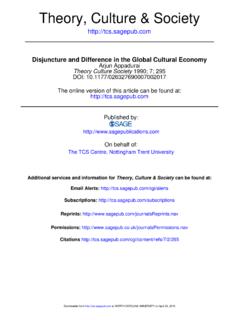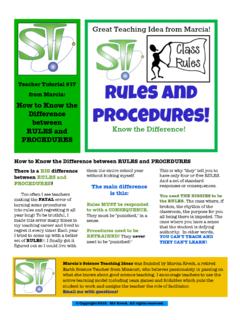Transcription of AnimalCloning Lesson4 cl - ActionBioscience
1 Lesson To accompany the peer-reviewed article by Lauren Pecorino, : Animal Cloning: Old MacDonald's Farm Is Not What It Used to Be (September 2000). Cloning Animals and Plants: Any Difference? (August 2004). Lesson by Lorelei Crerar, biology teacher Educator's section: p. 1-2. Student handout 1: p. 3-4. Grades & Levels: Student handout 2: p. 5-6. Handout 1: middle school high school (general) Student handout 3: p. 7. Handout 2: high school (general). Handout 3: high school (advanced/AP) undergraduate (year 1). Time Recommendations: Handout 1: one class period for most activities, some may take one week for research Handouts 2 and 3: five weeks or more for plant growth plus time for presentations NSES (USA) Content Standards, 9 12: NSES and Science as Inquiry: Abilities and Understanding . NSES Life Science: The cell NSES and Science and Technology: Abilities and Understanding . NSES Science in Personal & Social Perspectives: Science and technology in challenges NSES History and Nature of Science: Historical perspective Note: View the NSES content standards on this site to choose other curricular applications for additional activities at: NSES (USA) Content Standards, 5 8: NSES 2.
2 Science as Inquiry NSES 4. Life Science NSES 6. Science and Technology NSES 7. Science in Personal & Social Perspectives Learning Objectives: When the students have completed this lesson, they will understand the value of scientific inquiry have a better understanding of how plants and animals are cloned be able to present an informed, yet personal, view on cloning animals and plants Key Words Include: chromosome, clone, differentiated (differentiation), DNA, egg, fertilized egg, germ cell, mitochondrial DNA, nuclear transfer, roots, sex cells Preparation Article Discussion: See introduction for instructions and suggested questions, page 2. Handouts 3 and 4: Review handouts for materials and procedures required for experiments. See useful links for educators at the end of Pecorino's article for links to assessment resources that may help you create assessment strategies for activities in this lesson. Source: p. 1 of 6.
3 Lesson: Cloning Animals and Plants: Any Difference? By Lorelei Crerar 2004. Cloning Animals and Plants: Any Difference? For Educators: Article Discussion About the article by L. Pecorino: Animal Cloning: Old MacDonald's Farm Is Not What It Used to Be . Preparation: Ask students to read the online article by Lauren Pecorino, or print and distribute copies of the article. The questions (below) can be used in a number of ways. They can be copied and handed out to the students for them to answer on their own. This would make a great lesson plan for a substitute, especially if the students can do some research using the Internet on the topic of cloning. The Personal Viewpoint activity below is designed to be a read, group, share lesson (similar to think, pair, share ). So before the students read, divide them into groups of three or four based on their views of cloning as per the categories suggested in the activity. Placing them in this type of group will get similar interests together and allow for better discussions.
4 When everyone is finished reading, have the groups explain their platform and state either a contrasting point of view from the article or a view that matches their own. Personal viewpoint questions may require students to research pros and cons of cloning. See suggested links in learn more links and useful links for student research at the end of Pecorino's article. Article Content Questions: 1. How long have farmers been cloning animals? 2. How successful is the procedure of selecting and propagating the best of the herd? 3. How successful is cloning? 4. What two things make Dolly the sheep unique compared with animals that were cloned before her? 5. What is the importance of the fertilized egg for the rest of the body? 6. What is a differentiated cell? 7. What is involved in the process of nuclear transfer? 8. Who was the first scientist to clone an animal from an adult body cell? 9. Where do the chromosomes in the fertilized egg come from?
5 10. What five things can be seen as benefits derived from cloning? Article Extension Questions: 1. Are heart cells and liver cells exactly the same? Why or why not? 2. What happens to cause cells to become different types of cells in the body? 3. How do scientists know that DNA does not become irreversibly specialized and differentiated? 4. For each of Ms. Pecorino's last five points, find and describe two benefits from that point. Personal Viewpoint Place yourself into one of the following categories and find two or three other people who share your view. Think carefully before choosing. Your teacher may reorganize groups to balance group sizes. Animal cloning is a good thing. Animal cloning a bad thing. I know very little about animal and/or plant cloning. I know a lot about animal and/or plant cloning. Cloning is OK for plants and animals but not for humans. Share your views and answer questions on the article you read.
6 It would be very helpful to you to write down your current views on cloning and a little of what you know, even if you are not sure it is correct. Source: p. 2 of 6. Lesson: Cloning Animals and Plants: Any Difference? By Lorelei Crerar 2004. Cloning Animals and Plants: Any Difference? Student Handout 1. 1. Famous Animal Clones Create one of the following presentations: Storyboard for a short TV documentary (See Useful links for student research at the end of the article page for links to storyboarding information.). Feature article for your local newspaper Poster presentation for a science exhibit Choose one of the animals below for your presentation. Make sure you describe why the animal of your choice is important in the history of animal cloning. Dolly, the sheep Megan and Morag, the sheep Copycat, the cat Annie, the cow Xena, the pig Tetra, the monkey Cumulina, the mouse Promotea, the horse Idaho Gem, the mule 2.
7 Same or Different Worksheet Using all of the resources available to you, examine the similarities and differences between animal and plant cloning. You will work on this for one week. Be sure to visit the library as well as using the Internet. Remember when using the Internet that you need to use reliable sources. Use a separate sheet of paper if you need more room for your notes. Similarities differences Source: p. 3 of 6. Lesson: Cloning Animals and Plants: Any Difference? By Lorelei Crerar 2004. Cloning Animals and Plants: Any Difference? Student Handout 2. Introduction: Coleus is a plant that can form roots from a leaf cut from the plant. This produces a clone of the original plant because no sexual reproduction is taking place. A clone is an exact genetic copy of an organism. It must have exactly the same DNA. A clone is not the same age as the original organism. There are a number of methods for cloning animals, none of which is as simple as the plant cloning method used in the experiment below.
8 Objective: 1. Cloning a Coleus plant. 2. Arriving at conclusions based on data and observations. Materials: clear plastic cup soil scissors label aluminum foil water Coleus plant metric ruler Procedure: 1. Obtain a plastic cup and fill it with water until the water reaches 5. centimeters below the rim of the cup. 2. Cut a branch from one of the Coleus plants using sharp scissors. Be sure to cut the stem cleanly. 3. Place a piece of aluminum foil over the top of your cup as shown in the picture. 4. Carefully puncture a small hole in the center of the cup and insert the Coleus cutting. 5. Fill in the first part of your data table with your observations of the plant on the first day. 6. Continue observing the plant and measuring the roots for 13 class periods (5 weeks). Be sure to refill the water as the level drops. 7. Plant your plant in a small amount of dirt. You can either take your plant home or leave it in the room.
9 8. Answer the conclusion questions. Data and Observations: Date Describe the plant Presence of Length of roots roots? Source: p. 4 of 6. Lesson: Cloning Animals and Plants: Any Difference? By Lorelei Crerar 2004. Cloning Animals and Plants: Any Difference? Student Handout 2 cont'd . Conclusion: 1. Define clone. _____. 2. This plant was clearly not produced with the same procedure as the sheep Dolly. Why is it considered a clone? _____. _____. _____. _____. _____. 3. How long did it take for your plant to grow roots? _____. 4. Is there any other type of plant that can be cloned in this manner? Think of the vegetables you know about. _____. _____. _____. _____. 5. Look at the What lies ahead section of the article by Dr. Pecorino. Describe how this procedure for cloning can be applied to her list of the benefits of cloning. _____. _____. _____. _____. 6. Describe your views on cloning different organisms. _____. _____.
10 _____. 7. This lab has added to your knowledge of cloning, and your views may have changed as a result of what you have learned. Explain how your views about cloning have changed since reading the article and taking part in the activities. _____. _____. _____. _____. _____. Source: p. 5 of 6. Lesson: Cloning Animals and Plants: Any Difference? By Lorelei Crerar 2004. Cloning Animals and Plants: Any Difference? Student Handout 3. Objectives: 1. Design an experiment to clone a plant using the tissue culture propagation method. 2. Conduct the experiment and arrive at conclusions based on observations. 3. Compare, through literature research, how cloning animals differs from cloning plants. Introduction: A clone is an exact genetic copy of an organism. It must have exactly the same DNA. A clone is not the same age as the original organism. See Useful links for student research at the end of Dr. Pecorino's article for Internet sources that provide information on the term and technology.






